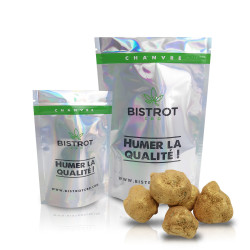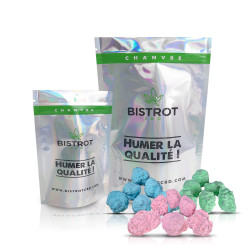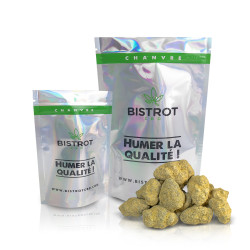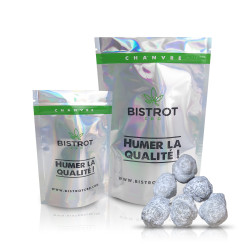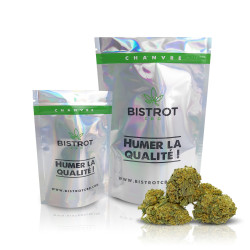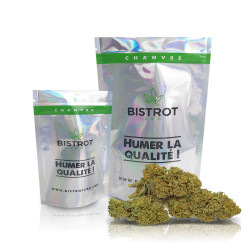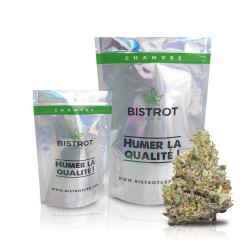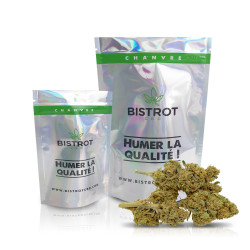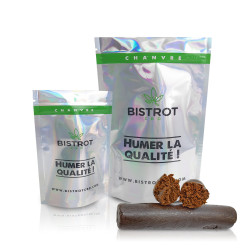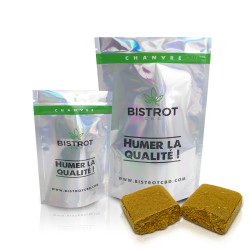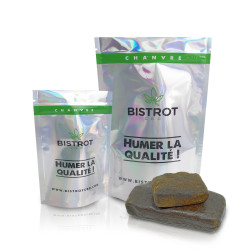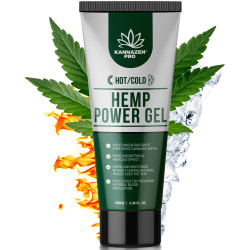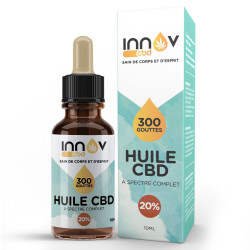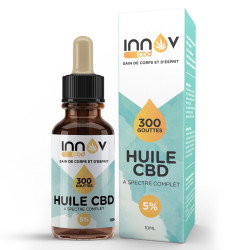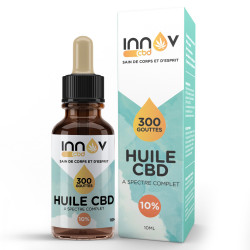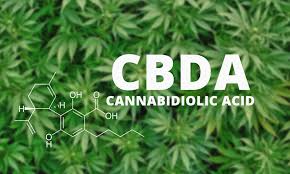
The
CBD
still feeds certain fantasies because of its origin (cannabis) by being assimilated to a drug. In reality, this is not the case! The stigmatization of cannabis in France is the consequence of the presence of another cannabinoid, the famous THC, (tetrahydrocannabinol). Indeed, the hedonic consumers covet it mainly for its psychotropic and euphoric effects. The confusion between CBD and THC comes from a lack of knowledge about cannabis.
If this plant is composed of different molecules (morphologies, effects, concentrations, …), they are still too often globalized under the generic term “cannabis”. As if it were a single substance. However, this is not the case! For users of CBD products, the distinction between these two cannabinoids is clear. But, the other cannabic components are still poorly known. Numerous scientific studies nevertheless highlight their potential in the entourage effect (molecular synergy optimizing the action of a substance). One molecule in particular has been of particular interest to researchers lately: cannabidiolic acid (CBDa).
The endocannabinoid system (ECS)
Hemp has a very interesting panel of substances. The latter are mainly synthesized in the trichomes (resin glands) and can be divided into 3 distinct groups:
– Terpenes: These are the main components of a resinous plant or essential oil. In cannabis, terpenes are responsible for organoleptic properties (taste and smell) and are very useful for pollination. They are also very popular with human consumers!
– Flavonoids: flavonoids are found throughout the plant kingdom. In hemp, there are 23 of them, the “cannaflavins”. Non psychoactive, these compounds have antioxidant, antibacterial and antiviral properties. Moreover, their actions contribute largely to the synergistic effects of cannabinoids.
– Cannabinoids and cannabinoid acids: In the case of hemp, they are also called phytocannabinoids (THCa, CBDa, CBGa, CBD, THC, CBN, …). These are chemical substances that interact more or less directly with the endocannabinoid receptors (CB1 and CB2) in our body. They are found throughout the body and, more specifically, in the central nervous system for CB1 and in the peripheral organs and immune system for CB2. They belong to the SEC responsible for the homeostasis of the body (regulation of body temperature, blood pressure, …). The affinity of some cannabinoids (THC) with CB1 or CB2 explains the multiple properties described by cannabis users (“cerebral high”, “body stone”). But not only! CBD, for example, will act on other targets. We list in particular natural enzymes of the SEC (anandamide) or the receptors of the serotonin (neurotransmitter also called “hormone of happiness”).
Cannabinoids
Among the most well-known cannabinoids in hemp are:
- THC (tetrahydrocannabinol): psychotropic molecule, illegal in France, euphoric and / or high.
- CBD (cannabidiol): non-psychotropic molecule, legal in France, relaxing.
If these molecules are naturally present in cannabis, their original concentrations in the plant are very low. Their contents, sometimes dizzy, announced by the retailers of marijuana (shop CBD or seed bank) are those of the finished product. In a fresh plant, it is not! It is actually a cannabinoid acid, CBDa (cannabidiolic acid), which is the one most found in hemp.
Definition of CBDa
CBDa, or cannabidiolic acid, is very closely related to CBD as it is its precursor. Indeed, when we observe the chemical formulas of these two molecules, we understand their relationship:
– CBDa: C22H30O4
– CBD: C21H30O2 (chemical formula identical to THC)
These two chemical formulas are very similar. But, if one observes well their formula, an atom of carbon and 2 atoms of oxygen differentiate them. Indeed, CBD results from a transformation of CBDa subjected to a heat source. It then loses its carboxyl acid group (COOH). This reaction is called: decarboxylation.
C21H29O2 – COOH ——————-> C21H30O2 + CO2
heat
The decarboxylation of CBDa into CBD is rather long and requires high temperatures (140-180°C). When a CBD cannabis consumer smokes, inhales, cooks or brews hemp flowers, they are actually consuming heavily heated CBDa. This last one undergoes then the transformation necessary to the absorption of the active cannabinoid, the CBD.
If CBDa is the precursor of CBD, it is itself derived from another cannabinoid, CBGa (cannabigerolic acid) (1). This molecule, with protective functions for the plant, is found very little in hemp. It occurs at the very beginning of a chain reaction catalyzed by a synthetase enzyme. This results in the main cannabinoid acids: THCa, CBDa and CBNa. These will give respectively, after a process of decarboxylation, the THC, the CBD and the CBN (cannabinol).
The effect of CBDa on anxiety, mood and seizures and other conditions
For a long time, CBDa was considered as a simple inactive form of CBD. But, that time is now over. Indeed, numerous scientific researches lend it multiple beneficial properties acting on :
- epilepsy: CBD has proven to be effective in reducing the symptoms of epilepsy.
Epidyolex
Epidyolex is the first adjuvant treatment with CBD authorized in France. This medication attenuates the convulsions caused by 2 severe forms of epilepsy (Lennox-Gastaut syndrome (LGS) or Dravet syndrome (DS) (2). An authorization to market the drug has allowed to push the experiments on the positive impacts of cannabis. It appears that the addition of a small amount of CBDa in the treatment optimizes (power, speed) the anti-epileptic effects. These results need to be confirmed with other studies. - Decrease of anxiety and stress: no experimentation on humans is described. On the other hand, in rats, treatments with CBDa show an anxiolytic action 10 to 100 times higher than with CBD (3).
The effect of CBDa on anxiety, mood and seizures and other conditions
But, CBDa has many other virtues such as :
- Anti-inflammatory: During an inflammation, an enzyme called cyclooxygenase-2 (COX-2) is released in the body. In 2008, the results of a scientific research revealed the potential of CBDa to selectively inhibit the activity of the cyclooxygenase-2 enzyme. This particularity is due to its structure and in particular, to its carboxyl acid group (4).
- Anti-pain: A study conducted in 2020 on rats with Rett syndrome (a rare neurological disorder characterized by severe behavioral and physiological symptoms), shows a decrease in pain sensitivity in the presence of chronic CBDa treatment (5).
- Breast cancer: In addition to inflammatory processes, the enzyme cyclooxygenase-2 is also involved in cancer cell proliferation (its activity is expressed in more than 40% of breast cancer cases). The 2008 experiment (2) mentioned above revealed the potential action of CBDa to inhibit COX-2 activity. There are several other scientific studies that support this study. They reveal a relative effectiveness of CBDa in slowing down the proliferation of metastases (6) (7).
- Nausea, vomiting: CBDa would have an interesting potential to relieve nausea and vomiting. Whether they are chronic or caused by the side effects of certain treatments (chemotherapy, etc.). Indeed, according to the results of a 2013 study done on rats and shrews (3), raw CBDa would have a more powerful action than CBD to reduce these disorders. In addition, it would activate serotonin 5-HT 1A receptors (which are activated in the presence of serotonin). These receptors would also be responsible for a variety of behaviors such as anxiety, appetite, cognition, learning, memory, mood, thermoregulation, etc..
CBDa products from our CBD farm
There is an impressive variety of CBD products (seed oil, hemp resin,
CBD flowers
balms, oil capsules…). But, the transformation of CBDa into CBD in the presence of heat greatly reduces the ability of a material to naturally contain this molecule. In fact, smoking, vaping, drying, cooking or brewing a CBDa product will cause it to decarboxylate. This results in an absorption of CBD. Therefore, ingestion or sublingual intake are preferred to get the most out of CBDa.
Types of CBDa products:
- fullspectrum hemp oil preserves all the compounds of the plant. In order to optimize the power and the speed of the effects, a sublingual intake of a few drops of oil (under the tongue) is strongly advised.
- The juice of fresh hemp leaves and flowers. The active substances of cannabis are mainly concentrated in these plant parts. Such a juice can only be obtained from a fresh plant (the CBDa in dried flowers is already partially degraded into CBD). This particularity complicates the feasibility of such a purchase given the French legislative norms on cannabis cultivation.
To conclude on CBDa
Like CBD, cannabidiolic acid promises serious therapeutic benefits for use in certain disorders (including inflammation). However, the numerous benefits of CBDa described in scientific studies on animals or in vitro will have to be deepened by experiments on humans. Indeed, at this stage, raw CBDa is not a drug in the true sense. However, it can accompany the classical therapeutic treatment if the latter is powerless against certain collateral evils, such as vomiting and nausea.
Our online store, bistro CBD, offers premium quality products. You will be able to benefit from the virtues of CBDa (among others) in our fullspectrum oils. In addition, we ensure the discretion of the shipments and this, in all France. All you have to do is order your favorite products and we will do the rest!
FAQ : CBDa
[sp_easyaccordion id=”10353″]
References:
- Purification and Characterization of Cannabidiolic-acid Synthase from Cannabis sativa L. Biochemical analysis of a novel enzyme that catalyzes the oxydocyclization of cannabigerolic acid to cannabidiolic acid; Futoshi Taura, Satoshi Morimoto and Yukihiro Shoyama, 1996, published in Journal of Biological Chemistry: https://www.jbc.org/content/271/29/17411.long
- Epidyolex oral solution 100mg/ml, 2019, ANSM: https://www.ansm.sante.fr/Activites/Autorisations-temporaires-d-utilisation-ATU/Referentiel-des-ATU-nominatives/Referentiel-des-ATU-nominatives/EPIDYOLEX-nbsp-100-mg-ml-solution-buvable
- Cannabidiolic acid prevents vomiting in Suncus murinus and nausea-induced behavior in rats by enhancing 5-HT1Areceptor activation, D Bolognini, EM Rock, […], and RG Pertwee, 2013, British Journal of Pharmacology: https: //www.ncbi.nlm.nih.gov/pmc/articles/PMC3596650/
- Cannabidiolic Acid as a Selective Cyclooxygenase-2 Inhibitory Component in Cannabis; Shuso Takeda, Koichiro Misawa, Ikuo Yamamoto and Kazuhito Watanabe, 2008, published in Drug Metabolism and disposition: https: //pubmed.ncbi.nlm.nih.gov/18556441/
- Chronic Treatment with Cannabidiolic Acid (CBDA) Reduces Thermal Pain Sensitivity in Male Mice and Rescues the Hyperalgesia in a Mouse Model of Rett Syndrome; Daniele Vigli, Livia Cosentino, Mattia Pellas, Bianca De Filippis, 2020, published in ScienceDirect: https: //www.sciencedirect.com/science/article/abs/pii/S0306452220306254
- Down-regulation of cyclooxygenase-2 (COX-2) by cannabidiolic acid in human breast cancer cells, Shuso Takeda 1, Hiroyuki Okazaki, Eriko Ikeda, Satomi Abe, Yasushi Yoshioka, Kazuhito Watanabe, Hironori Aramaki, 2014, The Journal of Toxicological Science: https: //pubmed.ncbi.nlm.nih.gov/25242400/
- Cannabidiolic acid-mediated selective down-regulation of c-fos in highly aggressive breast cancer MDA-MB-231 cells: possible involvement of its down-regulation in the abrogation of aggressiveness, Shuso Takeda, Taichi Himeno, Kazuhiro Kakizoe, Hiroyuki Okazaki, Tomoko Okada, Kazuhito Watanabe, Hironori Aramaki, 2017, Journal of Natural Medicines: https: //pubmed.ncbi.nlm.nih.gov/27530354/
